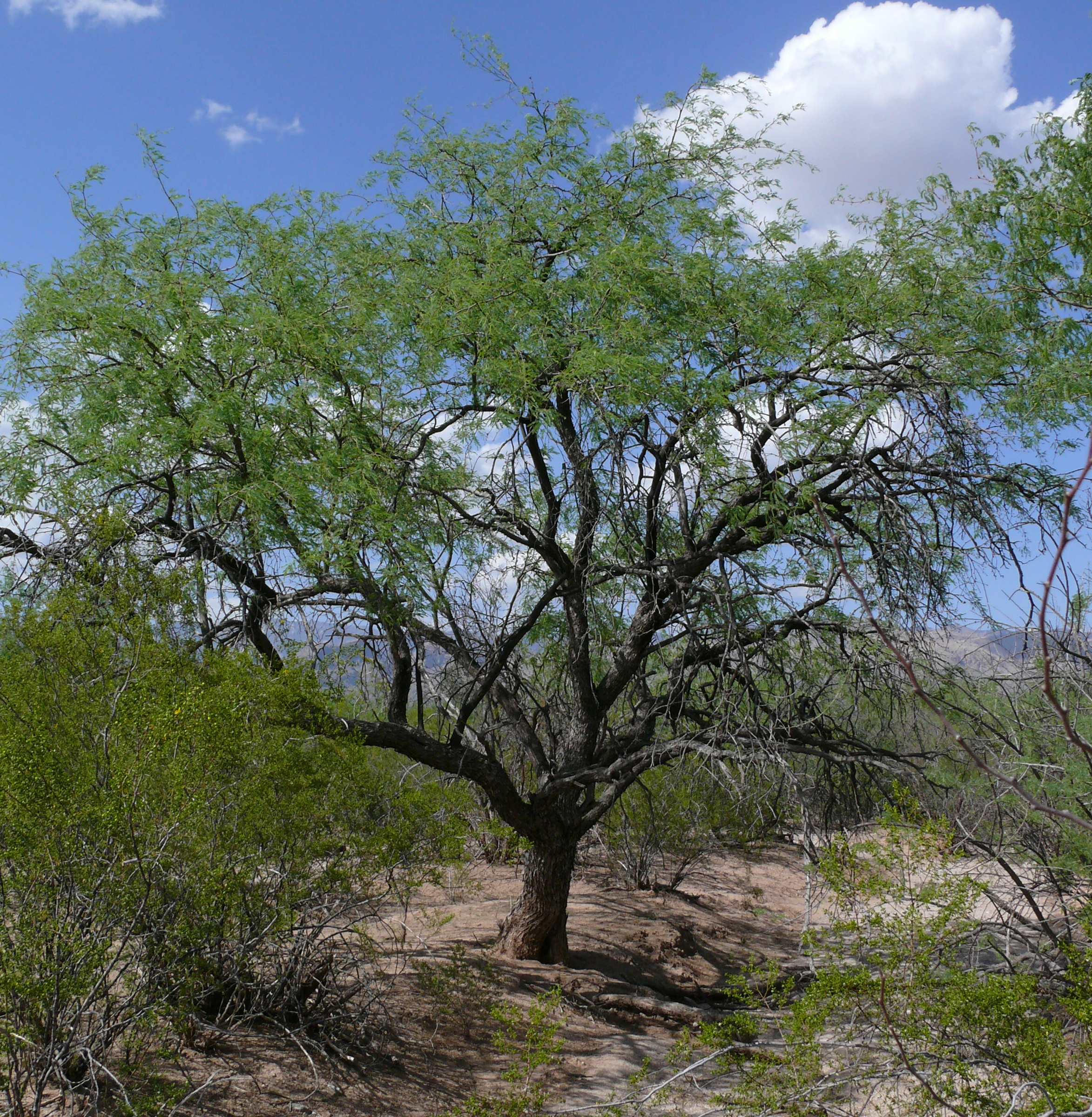- Prosopis velutina
Taxobox
name = Velvet Mesquite

image_width = 275px
regnum =Plantae
divisio = Magnoliophyta
classis =Magnoliopsida
ordo =Fabales
familia =Fabaceae
genus = "Prosopis "
species = "P. velutina"
binomial = "Prosopis velutina"
binomial_authority =Woot. Velvet Mesquite ("Prosopis veluntina") is a small to medium sized perennial tree. It is a
legume adapted to a dry, desert climate. Though considered to be a noxious weed in states outside its natural range, it plays a vital role in the ecology of theSonoran Desert .Range
The Velvet Mesquite is native to the Sonoran, Mojave, and Chihuahuan Deserts. It grows at elevations below 4,000 to 5,000 feet in desert grasslands and near washes. The main distribution is in central and southern Arizona and in adjacent Mexico. Near waterways mesquites can form deciduous woodlands called
bosque s.cite web
url=http://www.fs.fed.us/database/feis/plants/tree/provel/all.html
title=Prosopis velutina
publisher=www.fs.fed.us
accessdate=2008-05-01
last=
first=]Characteristics
The velvet mesquite can grow to 30-50 feet or higher. It grows larger in areas with ample water, smaller in open, dry grasslands. The youngest branches may be green and photosynthetic [Turner, Raymond M. 1963. Growth in four species of Sonoran Desert trees. Ecology. 44: 760-765.] . Young bark is reddish-brown and smooth. As it matures, it becomes a dark, dusty gray or brown and takes on a shredded texture. Yellow thorns up to one inch long appear on the young branches. The leaves are about three to six inches long, fine, and bipinnately compound. They fold closed at night. The branches are "undisciplined" and often gnarled. The
taproot sinks deep into the earth, far deeper than that height of the tree, taking advantage of water stores unaccessible to most plants. Roots extend to about fifty feet, but depths as much as 175 feet have been recorded.The mesquite is
deciduous , losing its leaves in winter and leafs out again in the spring when all danger of frost is past. Because of its deep root system, it keeps its leaves in the dry months of summer in all but the most severe drought years. The flowers are yellow and form in the spring (after the leaves) in dense cylindrical clusters (catkin s) roughly four inches long. Long pods form from the flowers. The pods are bright green and look a little like pea pods when they are young. They mature into brown, dry pods, each containing several hard, dry, brown seeds. The seeds need to be scarified before they can germinate. This scarification typically takes place in the digestive tract of animals, who eat the seeds and then deposit them widely, as the seed takes days to pass through the animal [Fisher, C. E.; Meadors, C. H.; Behrens, R.; [and others] . 1959. Control of mesquite on grazing lands. Bull. 935. College Station, TX: Texas Agricultural Experiment Station. 24 p. In cooperation with: U.S. Department of Agriculture.] .Place in the ecosystem
The mesquite contributes greatly to the desert ecosystem.
Coyote s, ground squirrels, javelinas, mule and white-tail deer, and jack rabbits all eat mesquite pods. Livestock also eat mesquite pods when available. Birds feed on the flower buds. As a member of the legume family, mesquites fix nitrogen in the soil. Mesquites can serve asnurse tree s to young cacti such as thesaguaro . The shade of its branches provides protection for small mammals, especially burrowing animals. Native Americans used the seeds for food, grinding them into a flour. The bark was used for baskets and fabrics and the wood for firewood and building. The leaves and gum were used as medicine.The range of the Velvet Mesquite has changed because of grazing. Cattle not only dispersed mesquite seeds, they also overgrazed the land, resulting in fewer range fires to control mesquite population. Mesquites grew more densely and spread into what had been grassland. Consequently, Velvet Mesquite is considered an invasive species or noxious weed in several states. [cite web
url=http://plants.usda.gov/java/nameSearch?keywordquery=prosopis+velutina
title=PLANTS Profile for Prosopis velutina (velvet mesquite) | USDA PLANTS
publisher=plants.usda.gov
accessdate=2008-05-01
last=
first=] On the other hand, mesquitebosque s cover only a small fraction of the area they covered before human settlement. Agriculture, fuelwood cutting, housing developments, and the lowering of the water table have all contributed to the loss of native mesquite stands.Velvet mesquite is also a common choice for residential and commercial
xeriscaping in Tucson and Phoenix, cities which are inside the Velvet Mesquite's natural range. An established mesquite tree needs little or no watering, and is an attractive ornamental.References
External links
* [http://plants.usda.gov/java/profile?symbol=PRVE Plant Profile for Prosopis velutina Woot. from the USDA Natural Resource Conservation Service]
* [http://www.itis.gov/servlet/SingleRpt/SingleRpt?search_topic=TSN&search_value=26883 Taxonomy, ITIS Report]
* [http://www.fs.fed.us/database/feis/plants/tree/provel/all.html Species information from the U.S. Forest Service]
* [http://calphotos.berkeley.edu/cgi/img_query?query_src=photos_index&where-taxon=Prosopis+velutina Photographs from CalPhotos]
* [http://seinet.asu.edu/seinet/symbiota/taxa/taxaprofile.php?taxon=Prosopis%20velutina&cl=Superstition%20Mountains%20Wilderness%20Area "Prosopis velutina" Pictures and herbarium specimen]
Wikimedia Foundation. 2010.
